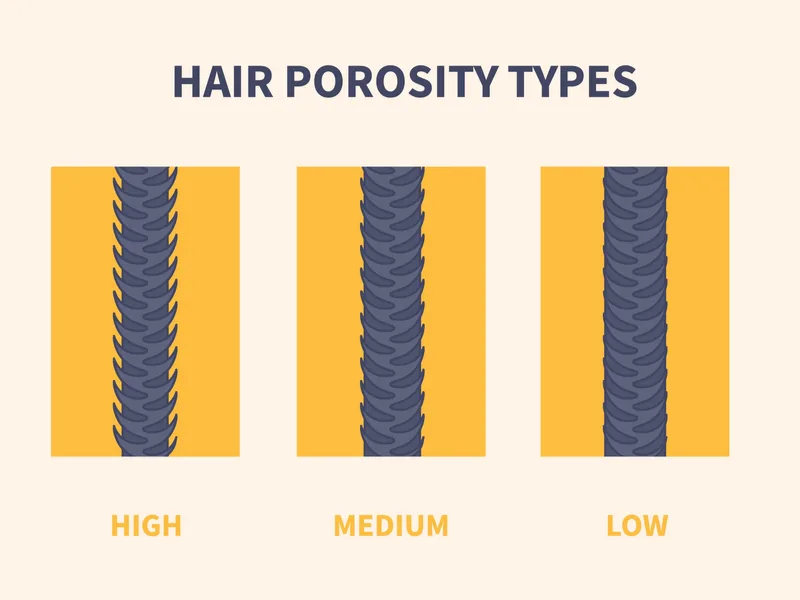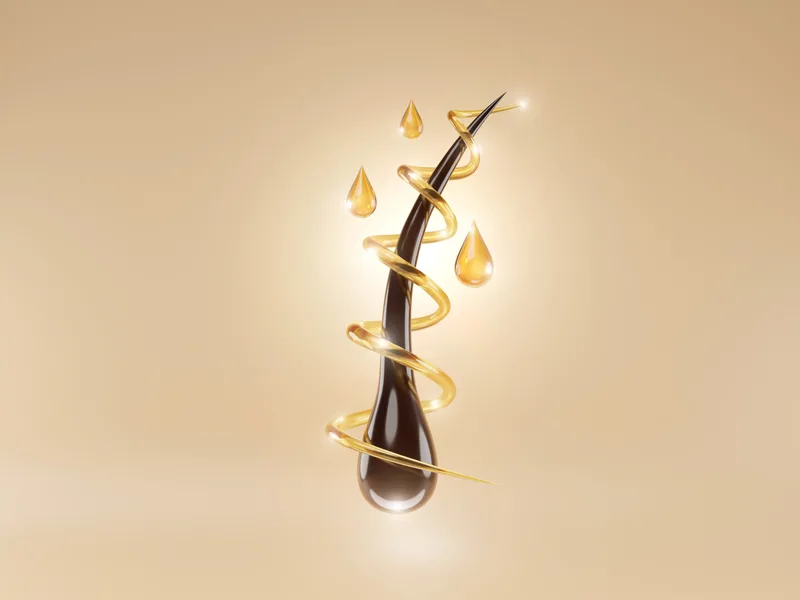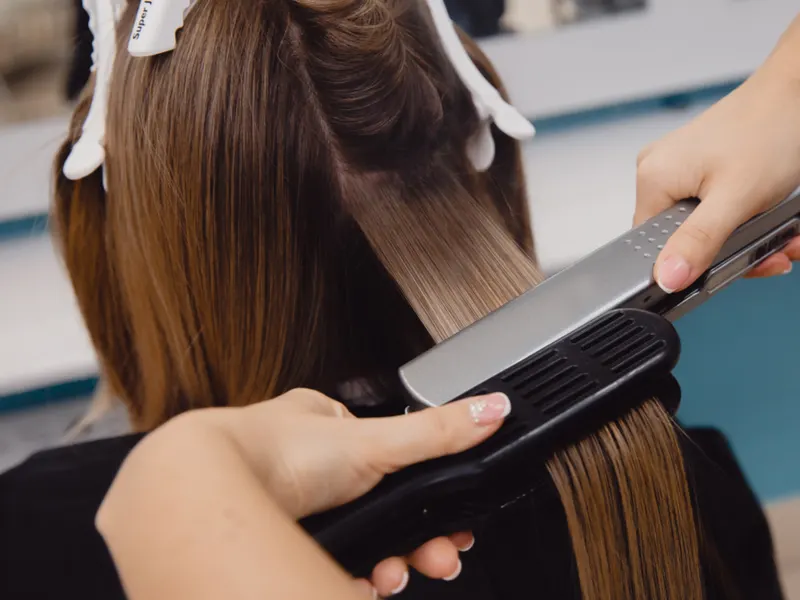Jump to:
There’s a lot of talk about keratin, so it might get you wondering, “is keratin good for low porosity hair?” Unfortunately, keratin is a poor choice for low porosity hair, and we’ll show you why below. Read on to learn more.
What Is Low Porosity Hair and Is Keratin Good for It?

art4stock/Shutterstock
Low porosity hair contains tightly packed, protein-rich cuticles, so adding more protein to your hair via keratin is a bad idea. We’ll show you why by covering the following:
- Keratin’s composition
- How to tell if you have low porosity hair
- Side effects of keratin on low porosity hair
- How keratin treatments work
- Tips for caring for low porosity hair
Using keratin on low porosity hair can cause breakage and dryness. But that’s not all—even protein-rich shampoos and conditioners can do the same. Read on for details and alternative, safer treatments.
The Balance Between Low Porosity and Keratin

atk work/Shutterstock
Keratin is a type of protein that lives inside and outside your body. It’s a crucial component to your system, supporting with the tissues that form the following:
- Hair
- Nails
- Skin
- Organ linings
Nevertheless, too much keratin in the body isn’t a good thing—it can cause numerous epithelial cell cancers. Luckily, you shouldn’t have to worry about external applications of keratin having such effects.
But regardless, it’s a bad idea to use keratin on low porosity hair, given that such hair types already have lots of protein.
How to Tell If You Have Low Porosity Hair
Low porosity hair occurs because your hair cuticles are too close together. That means that they have trouble opening wide enough to allow water and moisturizing products into them.
There are several signs to look for if you’re trying to determine if you have low porosity hair. They include:
- Beads of water form on top of your hair when you step into the shower
- Taking a long time for your hair to dry
- Lots of product build-up
- Greasy and dry hair
Although having both greasy and dry hair seems counterintuitive, the reason is that low porosity hair has cuticles that are too tight to properly absorb natural oils that your scalp creates.
Meanwhile, they can’t easily access conditioners you put on your hair, causing the hair to be both oily and dry. You can also try a water test to determine your hair’s porosity. To do so, place a strand or two of hair in a cup of water.
Then, let it sit for up to four minutes. If your hair sinks under the water, it’s safe to assume you have high to medium porosity hair. However, hair that floats is a tell-tale sign of low porosity. Or, just take our short, 30 second hair porosity quiz!
Why Keratin Is Bad for Low Porosity Hair
Although you can’t see the chemical makeup of your hair, trust us when we say that high protein content is one of the characteristics that cause hair to be low porosity.
Because low porosity hair already has more protein than it needs, treating it with keratin can have a devastating outcome. So, even though keratin is a refreshingly non-formaldehyde product, it’s not ideal for everyone.
In contrast, people with high porosity hair require keratin treatments for optimal hair health. That way, they can benefit from the more moisturized feeling that people with low porosity hair often already experience.
Side Effects of Too Much Protein in Hair
If you apply keratin to low porosity hair, you can expect to experience the following side effects over time:
- Dry hair
- Brittle hair
- Frequent hair breakage
Even if you fall under the medium porosity category, you may end up experiencing these symptoms if you’re closer to the low porosity end of the spectrum. Furthermore, such people and those with low porosity hair should look for protein-free shampoos and conditioners.
Read Next: What Is Protein Overload in Hair?
How Keratin Treatments Work

Parilov/Shutterstock
So now, to answer the question, “Is keratin good for low porosity hair?” First, it’s helpful to understand the step-by-step process of applying keratin to hair.
The purpose of a keratin treatment is to reduce frizz and give hair a smoother appearance by infusing the cuticles with this protein treatment. For this reason, people with fine, straight hair should avoid keratin treatments.
It just so happens that these people often have low porosity hair. Furthermore, commercial keratin gets its protein from wool or chicken feathers, so it’s an option that vegans of all porosity types will want to avoid.
However, if you have medium- or high-porosity hair, this is what you’ll do:
1. Shampoo
Although you can purchase keratin-infused shampoos and straighteners at the store, true keratin treatments happen in the salon and start with shampooing. Your hairdresser will use a clarifying shampoo to get rid of residue.
2. Application of Keratin
You’ll then return to the salon chair, where they’ll spray the keratin into your hair. They typically apply it in horizontal sections and use a comb to ensure the treatment reaches every hair strand.
3. Blow Dry
Your hairdresser will then dry your hair with a blow dryer. The heat helps keratin set into the hair, so they’ll also run a flat iron through your hair to help seal the treatment
You’ll need to hold off on washing your hair for 2 – 3 days. After that time, you can expect the keratin treatment to hold for around two months.
Care Tips for Low Porosity Hair
So, now that you know keratin is a terrible choice for using on low porosity hair, it might get you thinking — what kinds of treatments are helpful?
Below are some of the best ways to help your hair stay healthy and strong.
Use a Clarifying Shampoo
Applying clarifying shampoo to your hair every two weeks is an excellent way to keep grime out of your hair and promote new hair growth. Unlike standard shampoo, the clarifying variety contains ingredients to give your hair a deep clean.
Clarifying shampoo removes items such as:
- Air pollutants
- Product build-up
- Excess oils
As a result, clarifying shampoo will help strengthen your hair and prevent fading in color-treated hair. Although clarifying shampoo applications are outstanding for low porosity hair, using them in moderation is crucial.
Otherwise, your scalp could overproduce oil, leaving you to struggle even more with greasy hair. You can also make a clarifying “shampoo” at home. To do so, combine one cup of water with three tablespoons of apple cider vinegar and let it soak into your wet hair.
Put on a Shower Cap
It may not look glamourous, but wearing a shower cap on your dry hair overnight can be an excellent way to support your low porosity hair. Shower caps work so well because they trap heat from your head within the cap.
Since cuticles open wider with heat, they have a higher chance of benefiting from some of the moisture created from this greenhouse-like effect.
Furthermore, if you shower right after taking off your shower cap, your cuticles will be more open to receiving relatively more nutrients from your shampoo and conditioner than if you weren’t using it.
Avoid All Protein Products
When it comes to low porosity hair and protein, too much of a good thing is a bad thing. So, look for protein-free shampoos and conditioners at the store.
These products don’t always include protein-free on their label, given that to the general public that can sound like a negative. Therefore, you’ll need to look at their labels. Sometimes it’s easy to identify protein on a shampoo or conditioner bottle.
For example, the word “protein” often follows “soy” and “silk.” However, below are some protein ingredients in hiding that you might see on a label:
- Keratin
- Amino acids
- Biotin
- Hydrolyzed collagen
To make you juggle even more ingredients, we recommend using natural products on your hair. So, look for products that don’t contain wax, parabens, sulfates, or silicones.
Give Your Hair a Steaming
Yet another way to introduce heat into your hair to encourage the cuticles to open is by steaming it. You’ll need a cap for this one too. However, this time it’ll be a special steaming cap. Best of all, you don’t need to make a trip to the salon to use a steaming cap.
Instead, you can buy these relatively inexpensive items online and apply them yourself. In addition to increasing the moisture that your low propensity hair can absorb, steaming caps can also stimulate hair growth.
Try a Deep Heat Condition
We promise this is the last heat-related treatment you can do for low propensity hair, and it’s yet again an effective one. To start, choose a deep conditioner, following our suggestions above on ingredients to avoid.
Then, apply the conditioner to your hair based on the label’s instructions. In most cases, deep conditioners encourage users to leave the product on their hair for a while to let it set in. During this time, apply heat to your hair to get your cuticles to open.
A hooded dryer is ideal for a full-heat experience, but a blow dryer will work too. Then, rinse your conditioner and enjoy your new and improved moisturized low porosity hair.
You Might Also Like:
Frequently Asked Questions
If someone asks you, “Is keratin good for low porosity hair?” you now know to say “no.” However, you might still have some questions about this hair type, so we’re here to help.
Does low porosity hair need protein treatments?
No, low porosity hair doesn’t need protein treatments. That’s because this hair type already naturally creates plenty of protein. Therefore, we recommend looking for protein-free shampoos and conditioners.
Does low porosity hair need more product?
No, low porosity hair doesn’t need more product than medium to high porosity hair. The reason being is that the quantity of a product won’t impact its absorption into your cuticles. Therefore, adding more product to your hair will create build-up and a greasy appearance.
Can I increase the porosity of my hair?
You can encourage your hair to become more porous by eliminating treatments like keratin from your hair routine. Furthermore, using other protein-free products and heat will help open your cuticles, making them more absorbent.
How do I make my low porosity hair grow?
To help your low porosity hair grow, use a clarifying shampoo to remove product build-up every two weeks. Furthermore, moisturize it with lightweight oils, use deep conditioners, and avoid protein-based products like keratin.
Should you rinse low porosity hair with cold water?
No, it’s unnecessary to rinse low porosity hair with cold water. Doing so will close your hair’s cuticles. Given that low porosity hair already has an issue with keeping its cuticles closed tight, using cold water as a seal is unnecessary.
So, Is Keratin Good for Low Porosity Hair?
Low porosity hair doesn’t tolerate keratin well because the hair follicles already have too much protein. TThe best way to add moisture to your low porosity hair is by using protein-free hair products and heat to encourage moisture and nutrients to enter your hair.
